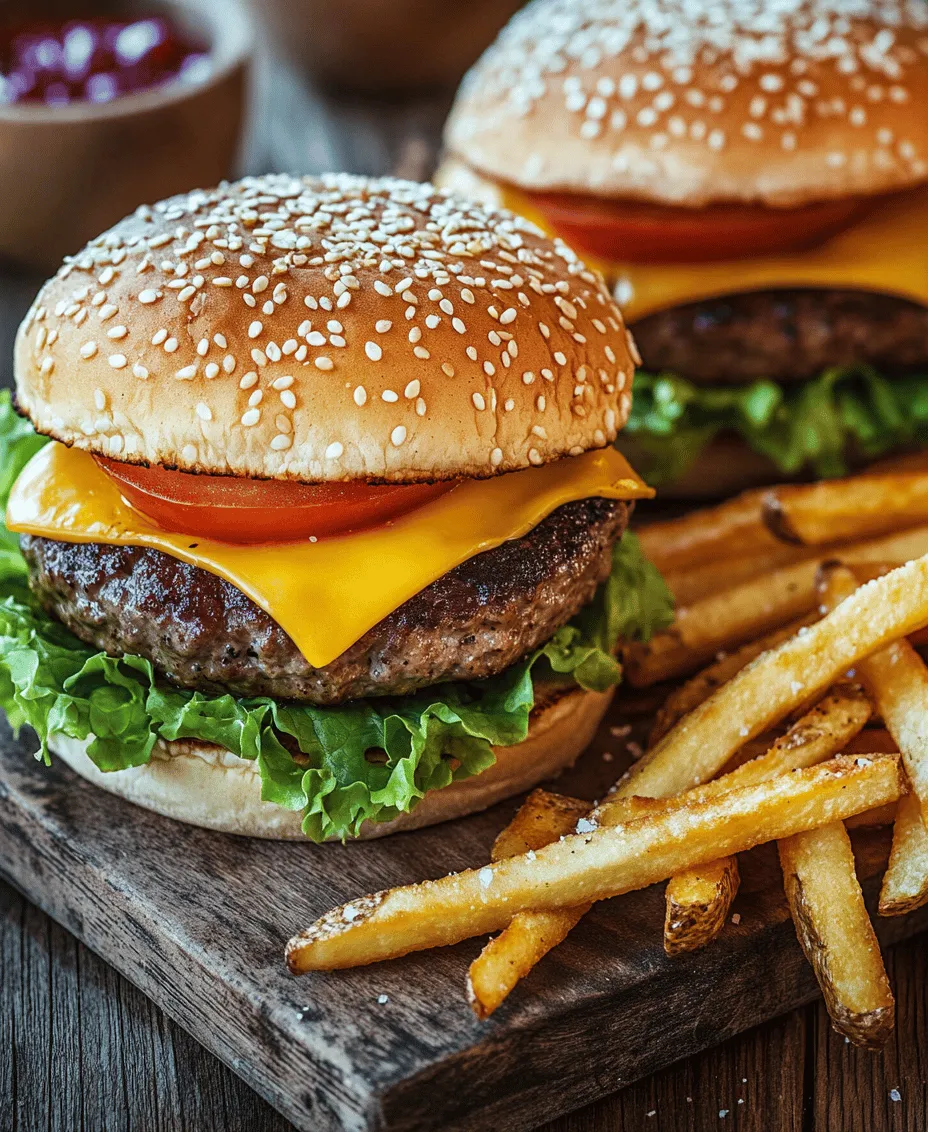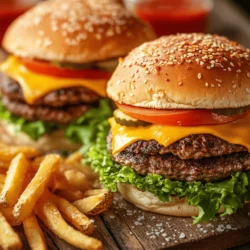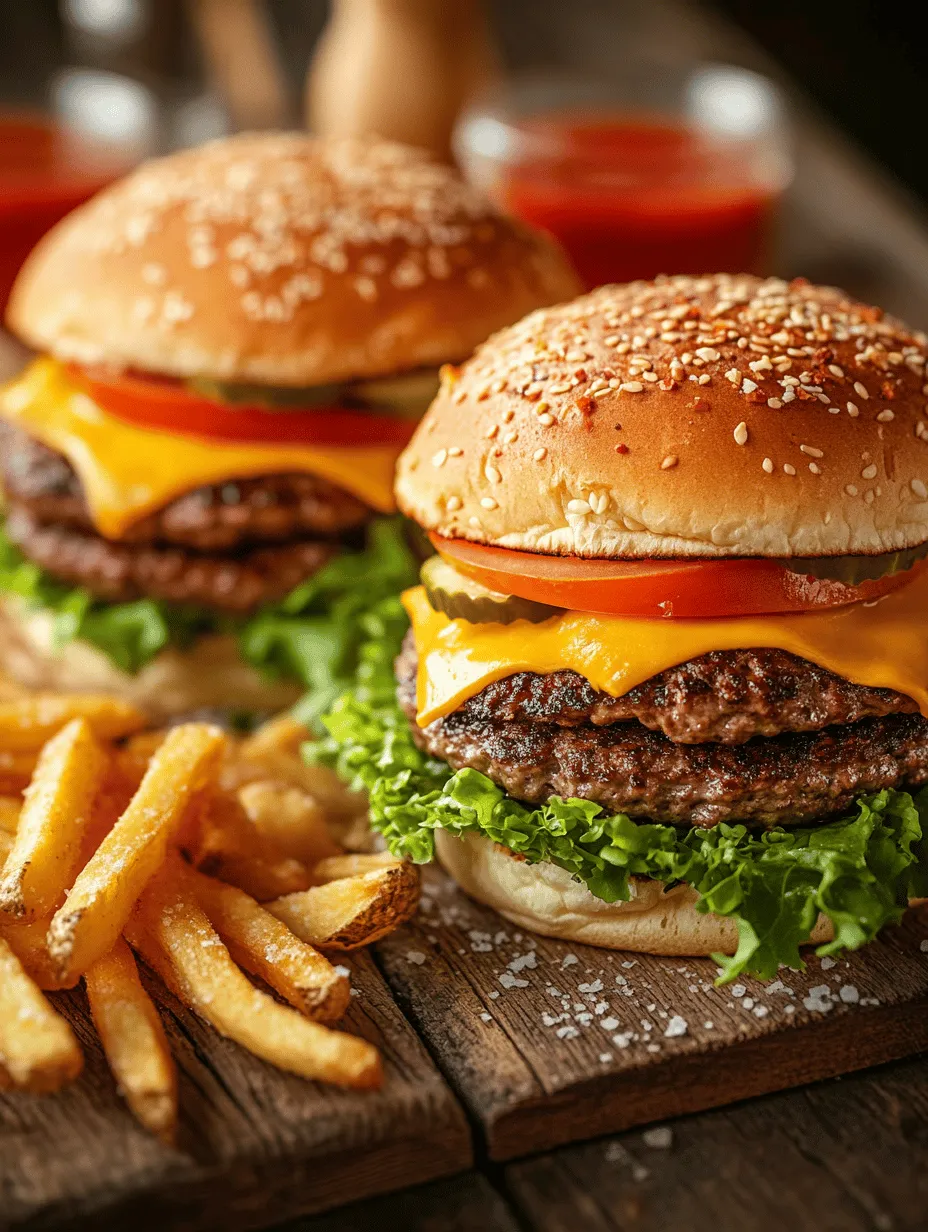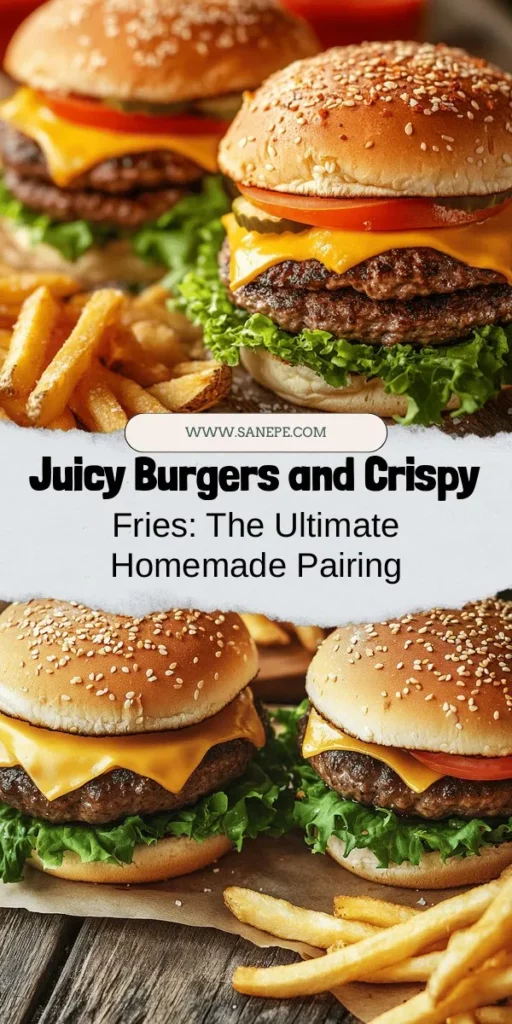Introduction
There’s an undeniable magic in the classic combo of burgers and fries. This beloved pairing has transcended generations, becoming a staple in kitchens and restaurants alike. While many enjoy the convenience of fast food, nothing quite compares to the mouthwatering experience of a homemade burger, bursting with flavor and paired with perfectly crispy fries. This article will guide you through the steps to create your own classic combo set, showcasing the importance of each ingredient and technique, ensuring that every bite is a testament to quality and taste.
Homemade burgers and fries not only allow for greater control over flavor and nutritional value but also provide an opportunity for creativity in the kitchen. Whether you’re hosting a summer barbecue, a casual family dinner, or simply indulging in a cozy night at home, this recipe will elevate your cooking game. Get ready to learn about the history of this iconic duo, the essential ingredients, and the steps to prepare the crispiest fries imaginable, all while crafting a juicy burger that will leave your taste buds singing.
Understanding the Classic Combo
History of Burgers and Fries as a Popular Food Pairing
The origins of the burger can be traced back to the late 19th century, with various claims attributing its invention to German immigrants who brought the concept of the “Hamburg steak” to America. The first hamburger as we know it—a ground beef patty served between two slices of bread—emerged in the early 20th century and quickly became a favorite in diners and drive-ins across the nation. Similarly, fries, often linked to Belgian cuisine, gained popularity in the United States during the same era, thanks in part to their accessibility and ease of preparation.
Together, burgers and fries represent a culinary union that has become embedded in American culture—and indeed, around the world. From backyard barbecues to late-night diners, this dynamic duo is a go-to for many, showcasing a simple yet satisfying meal that appeals to all ages.
Cultural Significance and Variations Around the World
While the American-style burger and fries reign supreme in the fast-food realm, variations abound globally. In Japan, for instance, the teriyaki burger brings a sweet and savory twist to the classic, while in India, the vada pav offers a spicy potato fritter option served in a bun. Fries, too, have their local adaptations, with poutine in Canada featuring fries topped with cheese curds and gravy, and the loaded fries of the American Southwest topped with jalapeños and melted cheese.
These variations highlight how the burger and fry combo not only satisfies hunger but also serves as a canvas for culinary creativity, reflecting local tastes and traditions. The appeal of homemade burgers and fries lies in the ability to tailor flavors to personal preferences, whether it’s opting for a leaner meat blend, experimenting with spices, or crafting the perfect dipping sauce for your fries.
Overview of the Appeal of Homemade Meals vs. Fast Food
In an age where convenience often takes precedence, the allure of fast food is undeniable. However, making burgers and fries at home offers numerous advantages that elevate the dining experience. Firstly, the quality of ingredients is paramount. Homemade meals allow you to select fresh, high-quality components, ensuring that your burgers aren’t just tasty but also nutritious.
Moreover, preparing your own meals fosters a connection to the food you eat; it becomes an experience rather than a transaction. The act of cooking can be therapeutic, and sharing the results with family and friends enhances the enjoyment. Finally, creating a meal from scratch allows for customization—whether you want to control the fat content of your burger, choose a gluten-free bun, or craft unique fry seasonings, the possibilities are endless.
Ingredients Breakdown
Why the 80/20 Ground Beef Blend is Ideal for Burgers
When it comes to crafting the perfect burger, the choice of meat plays a critical role in achieving the ideal balance of flavor, moisture, and tenderness. An 80/20 blend of ground beef—meaning 80% lean meat and 20% fat—is widely considered the gold standard for burger preparation. The fat content is essential, as it contributes juiciness and flavor, preventing the patty from becoming dry during cooking.
Using ground beef with too high a lean ratio can lead to lackluster burgers that lack the richness and moisture that makes each bite enjoyable. Conversely, a blend with too much fat can cause flare-ups on the grill and lead to greasy burgers. Therefore, the 80/20 ratio strikes the perfect balance, resulting in a flavorful and juicy burger that retains its shape when cooked.
Overview of Seasonings and Their Impact on Flavor
Seasoning is where the magic happens in burger preparation. While the quality of the meat is vital, the right blend of spices can elevate your burger to new heights. At the very least, kosher salt and freshly cracked black pepper are essential; they enhance the natural flavors of the beef without overpowering them.
Feel free to experiment further with garlic powder, onion powder, smoked paprika, or even a touch of cayenne pepper for a subtle kick. Each seasoning contributes to the overall flavor profile of the burger, creating a unique taste experience that can be tailored to suit personal preferences. Moreover, incorporating seasonings directly into the meat before cooking allows for deeper flavor penetration, ensuring that every bite is delicious.
Discussion on Bun Types and Their Importance in Burger Construction
The choice of bun is just as crucial as the patty itself. The ideal burger bun should complement the flavors of the meat while providing a sturdy base to hold all the delicious toppings. Brioche buns, with their slightly sweet flavor and soft texture, are popular for their ability to soak up juices without falling apart.
Alternatively, classic sesame seed buns offer a traditional touch, while whole wheat buns cater to those seeking a healthier option. For a gluten-free alternative, lettuce wraps or portobello mushrooms can serve as excellent substitutes. Regardless of the type of bun chosen, it’s essential to lightly toast it before assembling your burger. This not only adds a delightful crunch but also creates a barrier against moisture, preventing the bun from becoming soggy.
Description of Potato Varieties Suitable for Fries and Their Characteristics
When it comes to fries, the type of potato you choose can significantly affect the final result. Russet potatoes are the gold standard for making fries due to their high starch content and low moisture levels. This combination results in fries that are crispy on the outside and fluffy on the inside.
Yukon Gold potatoes also make a delightful fry option, offering a buttery flavor and creamy texture. However, they contain more moisture than Russets, which can impact crispiness if not cooked properly. Ultimately, the choice of potato will influence the fry’s texture, flavor, and overall satisfaction, making it a key component in the classic combo set.
Importance of Using Fresh Ingredients for Optimal Taste
Using fresh ingredients is paramount when preparing burgers and fries. Fresh produce adds vibrancy and flavor, allowing the natural sweetness of tomatoes, crunch of lettuce, and brightness of pickles to shine. Additionally, fresh herbs and condiments can enhance flavor profiles, making each component of your meal taste its best.
By opting for fresh ingredients, you not only improve the taste and quality of your dish but also promote better health. Fresh vegetables are rich in vitamins and minerals, contributing to a more balanced meal. Therefore, sourcing quality ingredients—whether from local farmers’ markets or your grocery store—is an investment in both flavor and nutrition.
Preparing the Fries
Step-by-Step Guide on Selecting and Preparing Russet Potatoes
To make the perfect fries, start with selecting the right Russet potatoes. Look for firm potatoes with smooth skin and no blemishes or sprouts. The size of the potatoes can vary, but medium-sized potatoes are typically best for uniform cutting.
Once you have your potatoes, it’s time to prepare them. Begin by washing and scrubbing the potatoes under running water to remove any dirt. After thoroughly rinsing, peel the potatoes if you prefer skinless fries; however, leaving the skin on can add a rustic touch and extra nutrients.
Importance of Soaking Potatoes for Crispiness
Soaking the cut potatoes in cold water is a crucial step that should not be overlooked. This process removes excess starch, which can make fries gummy during cooking. Soak the cut potatoes for at least 30 minutes, or even overnight if you have the time.
After soaking, drain the potatoes and pat them dry with a clean kitchen towel or paper towels. Removing excess moisture is essential to achieving that coveted crispy texture, as water on the surface can lead to steaming rather than frying.
Detailed Instructions on Cutting Potatoes for Uniform Cooking
When it comes to cutting your potatoes, uniformity is key. Aim for fries that are approximately ¼ to ½ inch thick, ensuring they cook at the same rate. To create even cuts, start by slicing the potato lengthwise into planks, then stack a few planks together and cut them into strips.
If you prefer thinner fries, you can opt for shoestring or French fry cuts. For thicker fries, known as steak fries, simply cut the strips wider. No matter what cut you choose, consistency ensures all your fries will reach the perfect level of crispness simultaneously.
Explanation of Seasoning Choices and Their Flavor Contributions
Seasoning your fries is where you can get creative. A simple combination of salt and pepper enhances the natural potato flavor, but you can take it a step further by experimenting with various seasonings. Garlic powder, onion powder, paprika, and even a sprinkle of Parmesan cheese can add depth and character to your fries.
For a twist, try tossing the cut potatoes with a bit of olive oil and your chosen seasonings before baking. This helps the seasonings adhere to the fries and ensures that every bite is flavorful.
Baking Tips for Achieving the Perfect Fry Texture and Color
The method of cooking your fries will dictate their final texture and color. For crispy baked fries, preheat your oven to 425°F (220°C) and line a baking sheet with parchment paper to prevent sticking. Spread the seasoned potatoes in a single layer, ensuring they have enough space to allow hot air to circulate around them.
Bake for about 30 to 40 minutes, flipping the fries halfway through to ensure even cooking. Keep an eye on them during the last few minutes, as the exact time may vary based on your oven and the thickness of the fries. The goal is to achieve a golden-brown color and a crispy exterior, with a soft and fluffy interior.
By following these steps and understanding the importance of each ingredient and technique, you’ll be well on your way to mastering the classic combo of juicy burgers and crispy fries. In the next section, we will explore the detailed preparation of the burgers, ensuring that every element of this iconic meal is executed perfectly.

Cooking the Burgers
To create the perfect juicy burger, the ratios of your ingredients and the mixing technique play an essential role in achieving that sought-after texture and flavor. Using the right balance of meat, fat, and seasoning is crucial. A common ratio is 80/20 (meat to fat), which provides the necessary moisture and flavor, ensuring that the burgers are neither dry nor greasy.
Step-by-Step Guide on Forming and Cooking Burger Patties
1. Prepare the Patty Mixture: In a large bowl, combine your ground beef, salt, pepper, and any additional seasonings. Use your hands to mix the ingredients gently. Over-mixing can lead to dense, tough patties, so mix just until everything is incorporated.
2. Form the Patties: Divide the mixture into equal portions (typically about 6 ounces each) and shape them into balls. Then, flatten each ball into a patty about ¾ to 1 inch thick. Use your thumb to create a slight indentation in the center of each patty. This will help the burgers cook evenly and prevent them from puffing up.
3. Chill Before Cooking: For best results, refrigerate the formed patties for about 30 minutes before cooking. This helps them hold their shape and enhances the juiciness during cooking.
4. Cooking Methods: You can either grill or skillet-cook your burgers. Grilling is ideal for achieving that classic smoky flavor, while skillet cooking allows for a more controlled cooking environment.
– Grilling: Preheat your grill to high heat. Once hot, place the patties on the grill and cook for about 3-4 minutes per side for medium-rare. Avoid pressing down on the patties, as this releases juices.
– Skillet Cooking: Heat a cast-iron skillet or a non-stick pan over medium-high heat. Add a little oil to the pan and once it shimmers, add the patties. Cook for about 4-5 minutes on each side, adjusting the temperature as necessary.
Tips for Achieving the Perfect Doneness and Cheese Melting Technique
To achieve the desired doneness, use a meat thermometer to check the internal temperature: 130°F for medium-rare, 140°F for medium, and 160°F for well-done. If you’re adding cheese, place a slice on each patty about one minute before you finish cooking. Cover the skillet or grill to trap the heat and help the cheese melt beautifully.
Importance of Bun Toasting for Enhanced Flavor and Texture
Don’t overlook the importance of toasting your burger buns. Spread a thin layer of butter on the cut sides of the buns, then toast them on the grill or in a skillet until golden brown. This step not only adds flavor but also creates a barrier that prevents the bun from becoming soggy when you add juicy toppings.
Assembling the Perfect Burger
Building the perfect burger is an art form. Let’s explore some creative ideas for layering ingredients that will take your burger to the next level.
1. Base Layer: Start with the toasted bottom bun. This is the foundation for your masterpiece.
2. First Layer – Lettuce: Add crisp lettuce to provide a refreshing crunch that balances the richness of the meat.
3. Patty Placement: Carefully place the cooked patty on top of the lettuce. This layer is crucial as it acts as the focal point of the burger.
4. Toppings and Sauces: Here’s where customization shines. Popular choices include slices of ripe tomato, sautéed onions, pickles, and crispy bacon. For sauces, consider traditional ketchup and mustard or more adventurous options like chipotle mayo or garlic aioli.
5. Cheese: If you didn’t melt the cheese on the patty, feel free to add a slice now. You can even use multiple cheese types for a gourmet touch.
6. Final Layer: Add a second layer of lettuce or a dollop of your favorite sauce, then crown it with the top bun.
7. Presentation: Cut the burger in half diagonally for visual appeal before serving. This also makes it easier for guests to manage their meal.
Serving Suggestions
Presentation is key when serving your classic burger and fries. Here are some ideal plating ideas to elevate your meal:
– Plating: Use a large plate to showcase the burger and fries side by side. Place the fries in a small metal basket or cone to add a touch of style.
– Garnishes: Consider garnishing your plate with a few sprigs of fresh herbs or a slice of pickle on the side for color and flavor contrast.
Pairing Your Burger and Fries with Beverages
No meal is complete without the perfect beverage. Consider pairing your classic burger and fries with refreshing sodas like cola or root beer. For a nostalgic touch, you might opt for a creamy milkshake in flavors like vanilla, chocolate, or strawberry. These drinks complement the rich flavors of the burger while providing a delightful contrast.
Discussing the Experience of Enjoying the Meal with Family and Friends
The joy of enjoying a homemade classic burger and fries is magnified when shared with loved ones. Set the table with a casual atmosphere, perhaps outdoors if weather permits, and encourage everyone to dig in. Sharing stories and laughter while savoring each bite creates lasting memories, making the meal even more enjoyable.
Nutritional Information
Understanding the nutritional values of your classic burger and fries is essential, especially for those mindful of their diet. Here’s a general breakdown of a standard serving:
– Calories: Approximately 600-800 calories for a burger with a bun, beef patty, cheese, and standard toppings.
– Fat: 35-45 grams, depending on the level of fat in the beef and cheese.
– Protein: 30-40 grams per serving.
– Carbohydrates: 40-50 grams, primarily from the bun and fries.
Portion Sizes and Mindful Eating Practices
While enjoying your burger and fries, it’s important to be conscious of portion sizes. A single burger with a side of fries can be satisfying, so consider serving smaller portions or sharing a larger order. Mindful eating practices, such as savoring each bite and paying attention to hunger cues, can enhance your dining experience.
Conclusion
There’s something incredibly satisfying about making and enjoying a homemade classic burger and fries. The process, from selecting the freshest ingredients to cooking and assembling the final product, allows you to take pride in your culinary skills. Plus, the ability to experiment with variations of the recipe means that no two meals need to be the same.
Whether you choose to stick with tradition or venture into new flavor territories, the joy of cooking at home is unmatched. Bringing people together through food fosters connection, conversation, and happiness. So gather your loved ones, roll up your sleeves, and dive into the delightful experience of crafting your perfect burger and fries at home!


